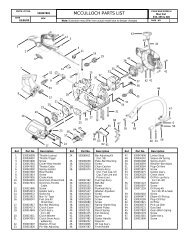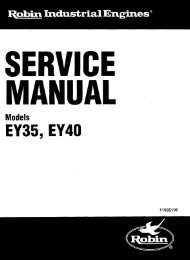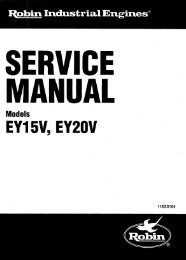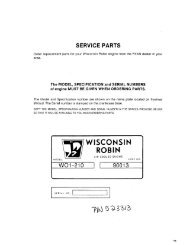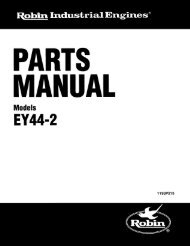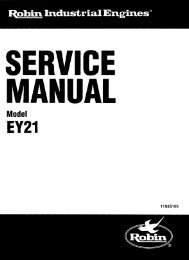EC05-2 - Jacks Small Engines
EC05-2 - Jacks Small Engines
EC05-2 - Jacks Small Engines
You also want an ePaper? Increase the reach of your titles
YUMPU automatically turns print PDFs into web optimized ePapers that Google loves.
7-3-3 FOR TIMING ADJUSTMENT, THE FOLLOWING PROCEDURES USING A TIMING,TESTER:<br />
Disconnect the stop button lead wires and the coil primary wire.<br />
Remove blower housing from engine.<br />
Connect the timing tester lead with red rubber cap to<br />
the coil primary wire and ground the lead with black<br />
rubber cap to crankcase. (See Fig. 7-3-3.) While the<br />
points are open, the buzzer within tester remains ringing<br />
and when the points are closed, the tester remains<br />
silent.<br />
Turn flywheel slowly counter-clockwise (D type and<br />
TIMI<br />
V type engines) or clockwise (B type engines) until the<br />
buzzer within tester becomes silent.<br />
Then, turn flywheel very slowly clockwise (D type and<br />
V type engines) or counter-clockwise (B type engines)<br />
\<br />
GROUND WIRE<br />
and stop immediately the moment the buzzer within<br />
tester begins ringing. Fig. 7-3-3<br />
Check if line mark on the flywheel is in the line with line mark on the crankcase. When the line marks are in alignment,<br />
the timing is correct.<br />
If the timing mark lines are not in alignment, then readjust the point opening according to the BREAKER POINT AD-<br />
JUSTMENT, by-removing the flywheel and repeat the checking procedures 3) through S).<br />
Afer completing the timing adjustment re-mount the blower housing and connect the coil to primary the stop lead button.<br />
MAGNETO’ TROUBLE SHOOTING<br />
When the engine does not start or starts with difficulty, or when its operation is unstable, the following tests<br />
they are caused by a defect in the magneto.<br />
will clarify if<br />
1) Check ignition cable for possible corrosion, broken, worn insulator or loose connection.<br />
2) Check the sparking as described later in this section.<br />
3) Check if the breaker points require cleaning, or adjusting or not. If the points are badly corroded or pitted. Condenser<br />
may have to be replaced.<br />
Refer to “BREAKER P0IN.T ADJUSTMENT”<br />
4) If no spark takes place, replace ignition coil.<br />
SPARK TESTING<br />
Remove spark plug from cylinder head and place it on blower housing, with the ignition cable connected to it.<br />
Crank the’ engine several times by starting pulley and observe the spark in the spark gap of spark plug. If the spark is strong,<br />
the ignition system can be eliminated as the source of trouble.<br />
If the spark is weak or there is no spark at all, repeat the checks according to the procedures 1) through 3) above. The<br />
The correct electrode gap is 0.5 - 0.7 mm.‘ (Refer to section 12. CHECKS and CORRECTION.”)<br />
-31 -





